Nursing Critical Thinking Argumentative Essay
VerifiedAdded on 2022/08/31
|9
|2630
|21
AI Summary
Contribute Materials
Your contribution can guide someone’s learning journey. Share your
documents today.
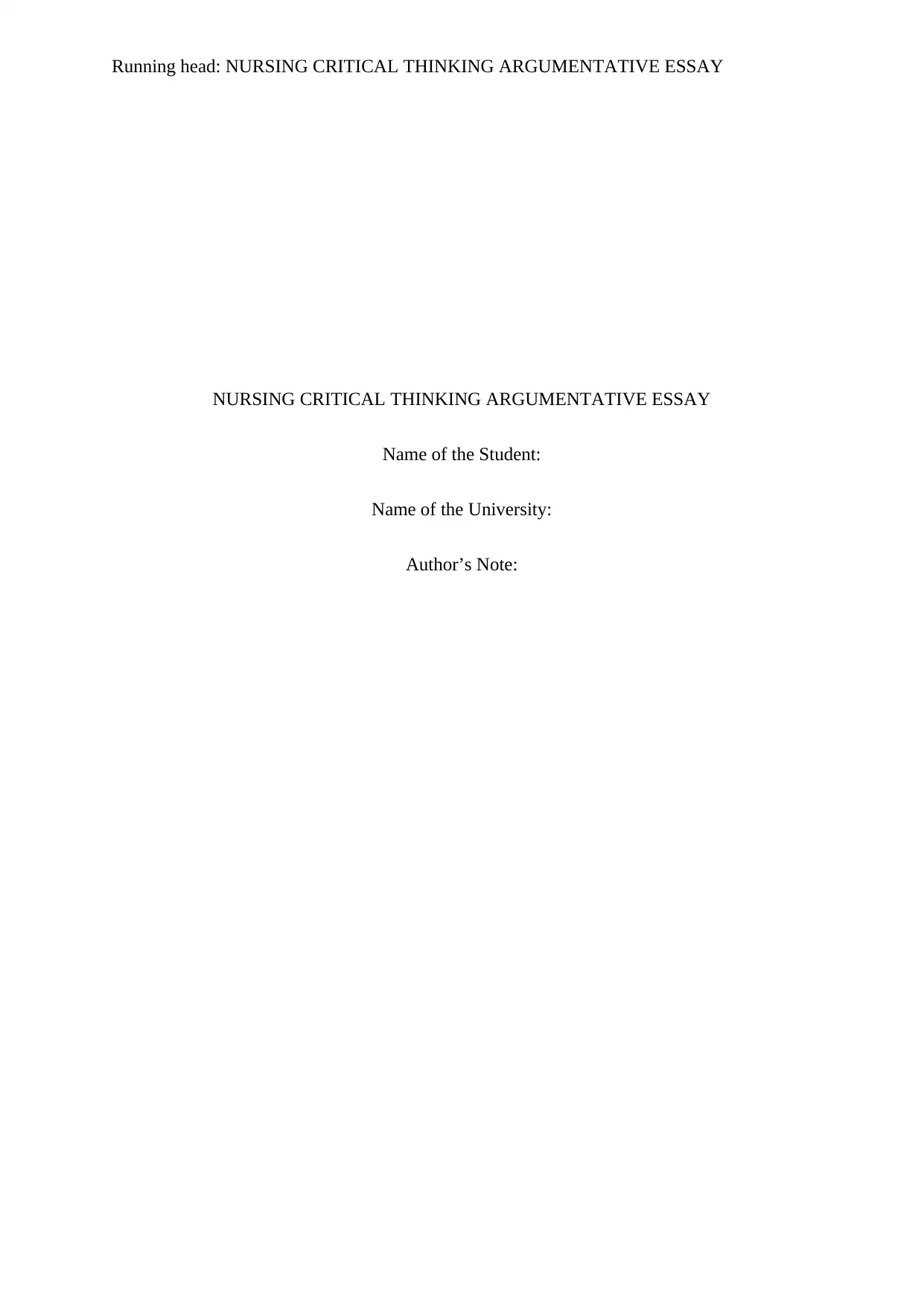
Running head: NURSING CRITICAL THINKING ARGUMENTATIVE ESSAY
NURSING CRITICAL THINKING ARGUMENTATIVE ESSAY
Name of the Student:
Name of the University:
Author’s Note:
NURSING CRITICAL THINKING ARGUMENTATIVE ESSAY
Name of the Student:
Name of the University:
Author’s Note:
Secure Best Marks with AI Grader
Need help grading? Try our AI Grader for instant feedback on your assignments.

1NURSING CRITICAL THINKING ARGUMENTATIVE ESSAY
Mental disorder is one of the prevalent disorders among the population that is
affecting the behavioural or mental patterns, thus, causing distress or impairment of mental
functioning. Therefore, identification and labelling of mental illness are considered as a
natural part of the help-seeking process (Horsfield et al., 2019). Keeley et al. (2016) opined
that the use of labels in the mental health field is stated to be contentious and is a topic of
debate over the years and is still continuing at every level. The classification system of
mental illness can be traced back to ancient times; however, the scientific classification of
mental disorder was done by Francois Boissier de Sauvages de Lacroix (Coste, 2017). The
system subdivided mental illness into four categories, hallucination, morositates, deliria and
folie Anomales. Much later, Psychiatric diagnostic classification systems were invented,
known as the Diagnostic and Statistical Manual of Mental Disorders (DSM) (Timimi, 2014)
However, various controversies were associated with it. The essay aims to critically analyse
the reason because of which psychiatric diagnostic classification systems should not be used
to determine whether the behaviour is abnormal.
The psychiatric diagnosis classification system has been criticised on the various
ground over the last few decades. The major reasons for such criticism are lack of reliable
data, validity issues. As per the opinion of Johnstone (2018), diagnosis in the psychiatric
system is supported by the idea that it is a branch of medicine where the main cause of
distress is the difficulties of an individual due to improper functioning of the brain. In
addition, medicine is a branch of science that includes reliable describing and grouping of the
basic elements that are governed by laws and theories that have been developed. Thus, it can
be stated that a lack of reliability and validity in drawing up diagnosis or proper classification
system is bound to raise fundamental issues in it. As found in the study of Prakash and Sagar
(2016), it was found that classification of mental health related disorders is stated to be
complex and complicated task and it is more critical in case of the psychiatric diseases. One
Mental disorder is one of the prevalent disorders among the population that is
affecting the behavioural or mental patterns, thus, causing distress or impairment of mental
functioning. Therefore, identification and labelling of mental illness are considered as a
natural part of the help-seeking process (Horsfield et al., 2019). Keeley et al. (2016) opined
that the use of labels in the mental health field is stated to be contentious and is a topic of
debate over the years and is still continuing at every level. The classification system of
mental illness can be traced back to ancient times; however, the scientific classification of
mental disorder was done by Francois Boissier de Sauvages de Lacroix (Coste, 2017). The
system subdivided mental illness into four categories, hallucination, morositates, deliria and
folie Anomales. Much later, Psychiatric diagnostic classification systems were invented,
known as the Diagnostic and Statistical Manual of Mental Disorders (DSM) (Timimi, 2014)
However, various controversies were associated with it. The essay aims to critically analyse
the reason because of which psychiatric diagnostic classification systems should not be used
to determine whether the behaviour is abnormal.
The psychiatric diagnosis classification system has been criticised on the various
ground over the last few decades. The major reasons for such criticism are lack of reliable
data, validity issues. As per the opinion of Johnstone (2018), diagnosis in the psychiatric
system is supported by the idea that it is a branch of medicine where the main cause of
distress is the difficulties of an individual due to improper functioning of the brain. In
addition, medicine is a branch of science that includes reliable describing and grouping of the
basic elements that are governed by laws and theories that have been developed. Thus, it can
be stated that a lack of reliability and validity in drawing up diagnosis or proper classification
system is bound to raise fundamental issues in it. As found in the study of Prakash and Sagar
(2016), it was found that classification of mental health related disorders is stated to be
complex and complicated task and it is more critical in case of the psychiatric diseases. One
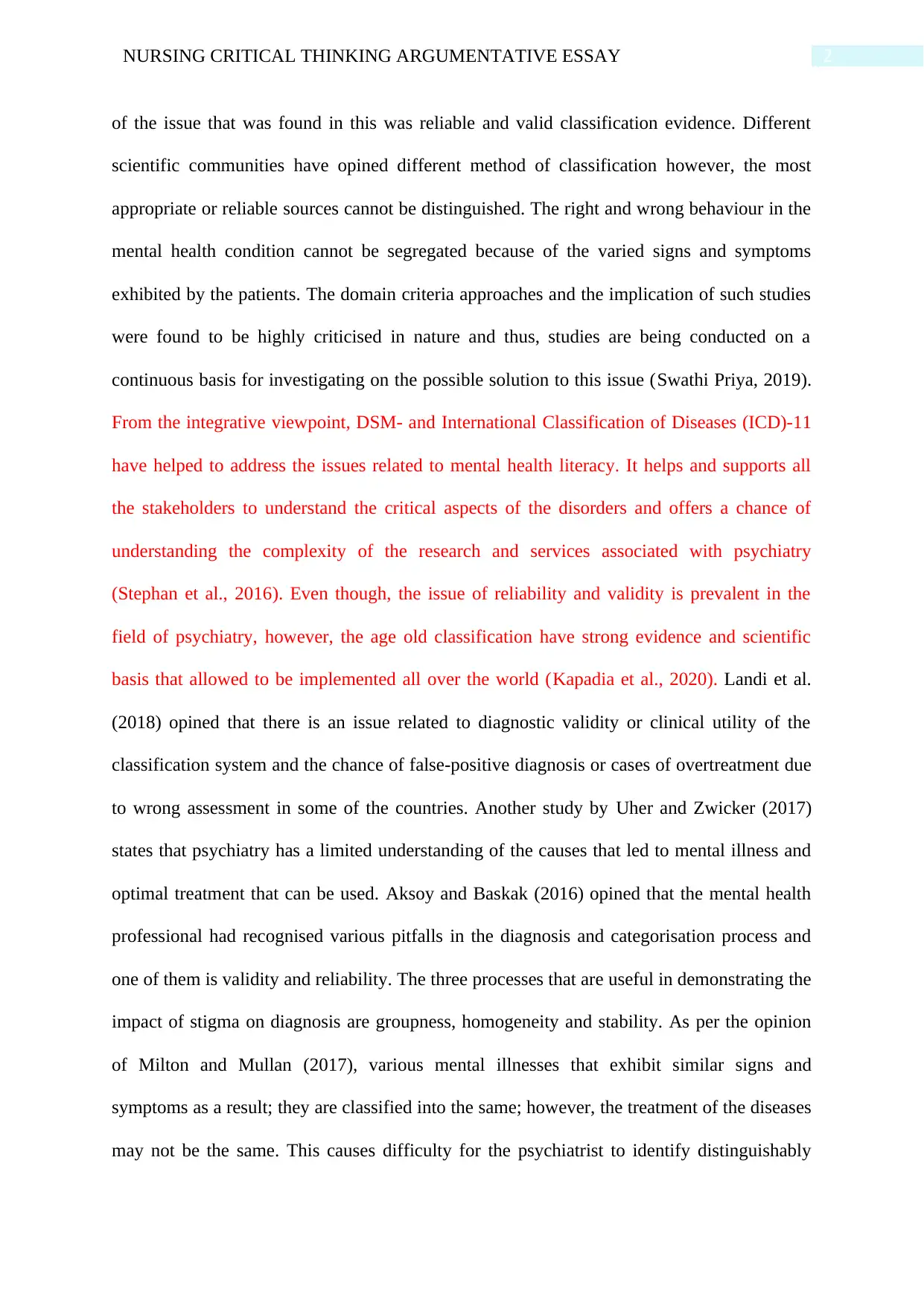
2NURSING CRITICAL THINKING ARGUMENTATIVE ESSAY
of the issue that was found in this was reliable and valid classification evidence. Different
scientific communities have opined different method of classification however, the most
appropriate or reliable sources cannot be distinguished. The right and wrong behaviour in the
mental health condition cannot be segregated because of the varied signs and symptoms
exhibited by the patients. The domain criteria approaches and the implication of such studies
were found to be highly criticised in nature and thus, studies are being conducted on a
continuous basis for investigating on the possible solution to this issue (Swathi Priya, 2019).
From the integrative viewpoint, DSM- and International Classification of Diseases (ICD)-11
have helped to address the issues related to mental health literacy. It helps and supports all
the stakeholders to understand the critical aspects of the disorders and offers a chance of
understanding the complexity of the research and services associated with psychiatry
(Stephan et al., 2016). Even though, the issue of reliability and validity is prevalent in the
field of psychiatry, however, the age old classification have strong evidence and scientific
basis that allowed to be implemented all over the world (Kapadia et al., 2020). Landi et al.
(2018) opined that there is an issue related to diagnostic validity or clinical utility of the
classification system and the chance of false-positive diagnosis or cases of overtreatment due
to wrong assessment in some of the countries. Another study by Uher and Zwicker (2017)
states that psychiatry has a limited understanding of the causes that led to mental illness and
optimal treatment that can be used. Aksoy and Baskak (2016) opined that the mental health
professional had recognised various pitfalls in the diagnosis and categorisation process and
one of them is validity and reliability. The three processes that are useful in demonstrating the
impact of stigma on diagnosis are groupness, homogeneity and stability. As per the opinion
of Milton and Mullan (2017), various mental illnesses that exhibit similar signs and
symptoms as a result; they are classified into the same; however, the treatment of the diseases
may not be the same. This causes difficulty for the psychiatrist to identify distinguishably
of the issue that was found in this was reliable and valid classification evidence. Different
scientific communities have opined different method of classification however, the most
appropriate or reliable sources cannot be distinguished. The right and wrong behaviour in the
mental health condition cannot be segregated because of the varied signs and symptoms
exhibited by the patients. The domain criteria approaches and the implication of such studies
were found to be highly criticised in nature and thus, studies are being conducted on a
continuous basis for investigating on the possible solution to this issue (Swathi Priya, 2019).
From the integrative viewpoint, DSM- and International Classification of Diseases (ICD)-11
have helped to address the issues related to mental health literacy. It helps and supports all
the stakeholders to understand the critical aspects of the disorders and offers a chance of
understanding the complexity of the research and services associated with psychiatry
(Stephan et al., 2016). Even though, the issue of reliability and validity is prevalent in the
field of psychiatry, however, the age old classification have strong evidence and scientific
basis that allowed to be implemented all over the world (Kapadia et al., 2020). Landi et al.
(2018) opined that there is an issue related to diagnostic validity or clinical utility of the
classification system and the chance of false-positive diagnosis or cases of overtreatment due
to wrong assessment in some of the countries. Another study by Uher and Zwicker (2017)
states that psychiatry has a limited understanding of the causes that led to mental illness and
optimal treatment that can be used. Aksoy and Baskak (2016) opined that the mental health
professional had recognised various pitfalls in the diagnosis and categorisation process and
one of them is validity and reliability. The three processes that are useful in demonstrating the
impact of stigma on diagnosis are groupness, homogeneity and stability. As per the opinion
of Milton and Mullan (2017), various mental illnesses that exhibit similar signs and
symptoms as a result; they are classified into the same; however, the treatment of the diseases
may not be the same. This causes difficulty for the psychiatrist to identify distinguishably
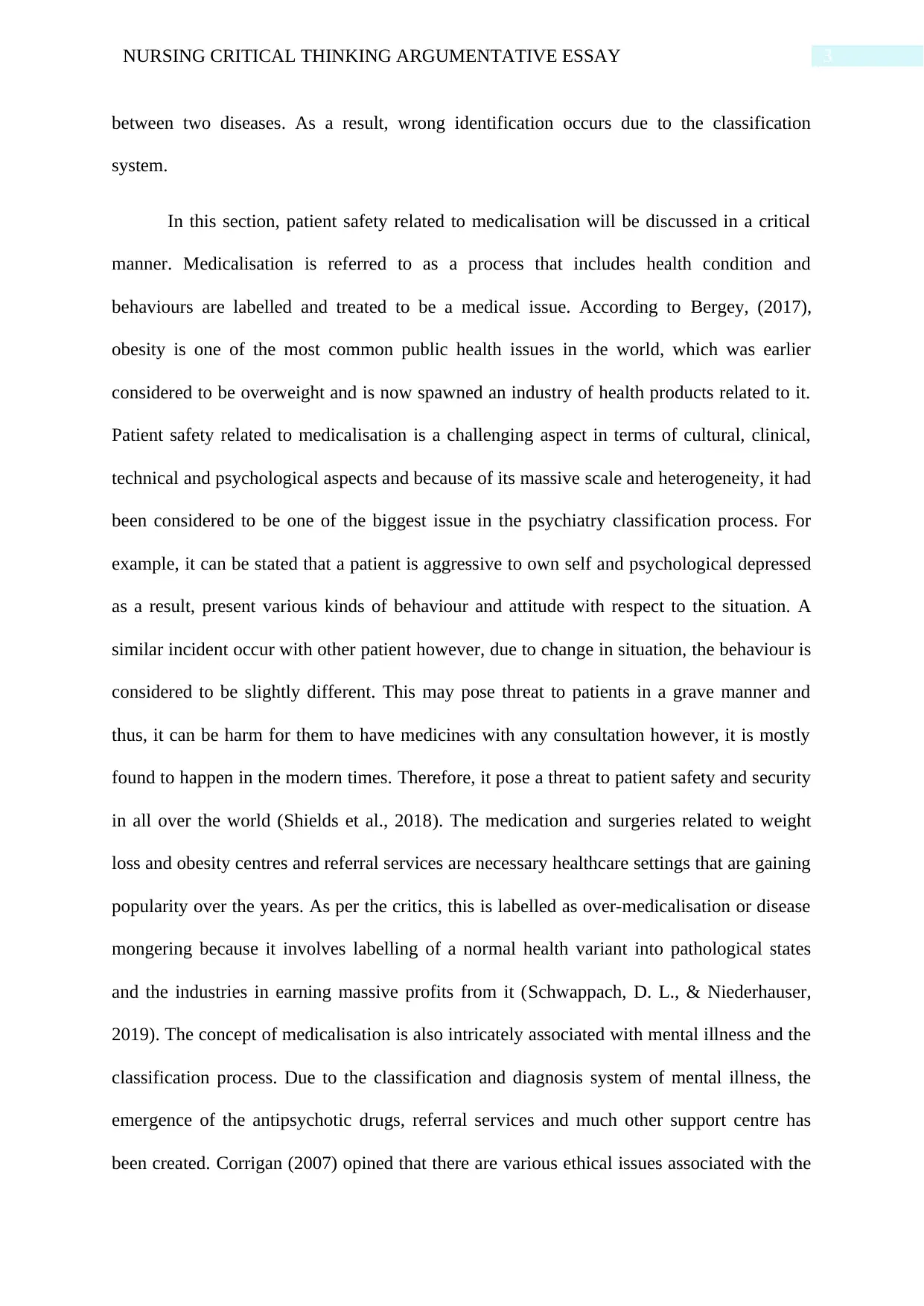
3NURSING CRITICAL THINKING ARGUMENTATIVE ESSAY
between two diseases. As a result, wrong identification occurs due to the classification
system.
In this section, patient safety related to medicalisation will be discussed in a critical
manner. Medicalisation is referred to as a process that includes health condition and
behaviours are labelled and treated to be a medical issue. According to Bergey, (2017),
obesity is one of the most common public health issues in the world, which was earlier
considered to be overweight and is now spawned an industry of health products related to it.
Patient safety related to medicalisation is a challenging aspect in terms of cultural, clinical,
technical and psychological aspects and because of its massive scale and heterogeneity, it had
been considered to be one of the biggest issue in the psychiatry classification process. For
example, it can be stated that a patient is aggressive to own self and psychological depressed
as a result, present various kinds of behaviour and attitude with respect to the situation. A
similar incident occur with other patient however, due to change in situation, the behaviour is
considered to be slightly different. This may pose threat to patients in a grave manner and
thus, it can be harm for them to have medicines with any consultation however, it is mostly
found to happen in the modern times. Therefore, it pose a threat to patient safety and security
in all over the world (Shields et al., 2018). The medication and surgeries related to weight
loss and obesity centres and referral services are necessary healthcare settings that are gaining
popularity over the years. As per the critics, this is labelled as over-medicalisation or disease
mongering because it involves labelling of a normal health variant into pathological states
and the industries in earning massive profits from it (Schwappach, D. L., & Niederhauser,
2019). The concept of medicalisation is also intricately associated with mental illness and the
classification process. Due to the classification and diagnosis system of mental illness, the
emergence of the antipsychotic drugs, referral services and much other support centre has
been created. Corrigan (2007) opined that there are various ethical issues associated with the
between two diseases. As a result, wrong identification occurs due to the classification
system.
In this section, patient safety related to medicalisation will be discussed in a critical
manner. Medicalisation is referred to as a process that includes health condition and
behaviours are labelled and treated to be a medical issue. According to Bergey, (2017),
obesity is one of the most common public health issues in the world, which was earlier
considered to be overweight and is now spawned an industry of health products related to it.
Patient safety related to medicalisation is a challenging aspect in terms of cultural, clinical,
technical and psychological aspects and because of its massive scale and heterogeneity, it had
been considered to be one of the biggest issue in the psychiatry classification process. For
example, it can be stated that a patient is aggressive to own self and psychological depressed
as a result, present various kinds of behaviour and attitude with respect to the situation. A
similar incident occur with other patient however, due to change in situation, the behaviour is
considered to be slightly different. This may pose threat to patients in a grave manner and
thus, it can be harm for them to have medicines with any consultation however, it is mostly
found to happen in the modern times. Therefore, it pose a threat to patient safety and security
in all over the world (Shields et al., 2018). The medication and surgeries related to weight
loss and obesity centres and referral services are necessary healthcare settings that are gaining
popularity over the years. As per the critics, this is labelled as over-medicalisation or disease
mongering because it involves labelling of a normal health variant into pathological states
and the industries in earning massive profits from it (Schwappach, D. L., & Niederhauser,
2019). The concept of medicalisation is also intricately associated with mental illness and the
classification process. Due to the classification and diagnosis system of mental illness, the
emergence of the antipsychotic drugs, referral services and much other support centre has
been created. Corrigan (2007) opined that there are various ethical issues associated with the
Secure Best Marks with AI Grader
Need help grading? Try our AI Grader for instant feedback on your assignments.

4NURSING CRITICAL THINKING ARGUMENTATIVE ESSAY
recent trend of medicalisation linked with mental illness. One of the most predominant
ethical concern is patient safety as most of the pharmaceutical and biological companies ate
investing in psychiatric products and are determined to sell them to a large population. It can
be found that several folds of antipsychotic medications are sold without prescriptions in
many parts of the world. This is primarily done because of the substantial marketing
strategies of the companies to make profits. Medicalisation related to patient safety is related
to the social control that can be linked with discrimination and racism. According to Perry et
al. (2018), the concept of medicalisation have an impact on the social aspect of race and
gender. The treatment of mental illness occurred at home that usually overlooked the
recovery. Conversely, in modern times, mental treatment occurs in hospitals that include
medication, monitoring system and other services that critically highlight the recovery-
approach. This is associated with stigma as society gets to know that the individual is not
mentally stable; as a result, various discrimination behaviour is found to be occurring
(Hyman, 2010).The people are now able to understand that illness from the diagnostic, which
radically change the profile and decimate. Even in case of mild mental distress, society
elevates the issue causing more pressure on the individual, family member and society
(Prakash & Sagar, 2016). This affects social wellbeing, thus; increase the percentage of
suicide due to this is common. According to another study conducted by Uher and Zwicker
(2017), the determination of behaviour, being abnormal can be triggered due to a number of
factors and, thus, can be mitigated by its own. This does not apparently indicate mental
illness and does not require medical or any psychotic services. However, in the modern era, a
slight change in behaviour is stated to be a big issue and thus, unreasonable actions are
conducted that may be a false alarm. This involves stigmatisation, loss of economic resources
and time.
recent trend of medicalisation linked with mental illness. One of the most predominant
ethical concern is patient safety as most of the pharmaceutical and biological companies ate
investing in psychiatric products and are determined to sell them to a large population. It can
be found that several folds of antipsychotic medications are sold without prescriptions in
many parts of the world. This is primarily done because of the substantial marketing
strategies of the companies to make profits. Medicalisation related to patient safety is related
to the social control that can be linked with discrimination and racism. According to Perry et
al. (2018), the concept of medicalisation have an impact on the social aspect of race and
gender. The treatment of mental illness occurred at home that usually overlooked the
recovery. Conversely, in modern times, mental treatment occurs in hospitals that include
medication, monitoring system and other services that critically highlight the recovery-
approach. This is associated with stigma as society gets to know that the individual is not
mentally stable; as a result, various discrimination behaviour is found to be occurring
(Hyman, 2010).The people are now able to understand that illness from the diagnostic, which
radically change the profile and decimate. Even in case of mild mental distress, society
elevates the issue causing more pressure on the individual, family member and society
(Prakash & Sagar, 2016). This affects social wellbeing, thus; increase the percentage of
suicide due to this is common. According to another study conducted by Uher and Zwicker
(2017), the determination of behaviour, being abnormal can be triggered due to a number of
factors and, thus, can be mitigated by its own. This does not apparently indicate mental
illness and does not require medical or any psychotic services. However, in the modern era, a
slight change in behaviour is stated to be a big issue and thus, unreasonable actions are
conducted that may be a false alarm. This involves stigmatisation, loss of economic resources
and time.
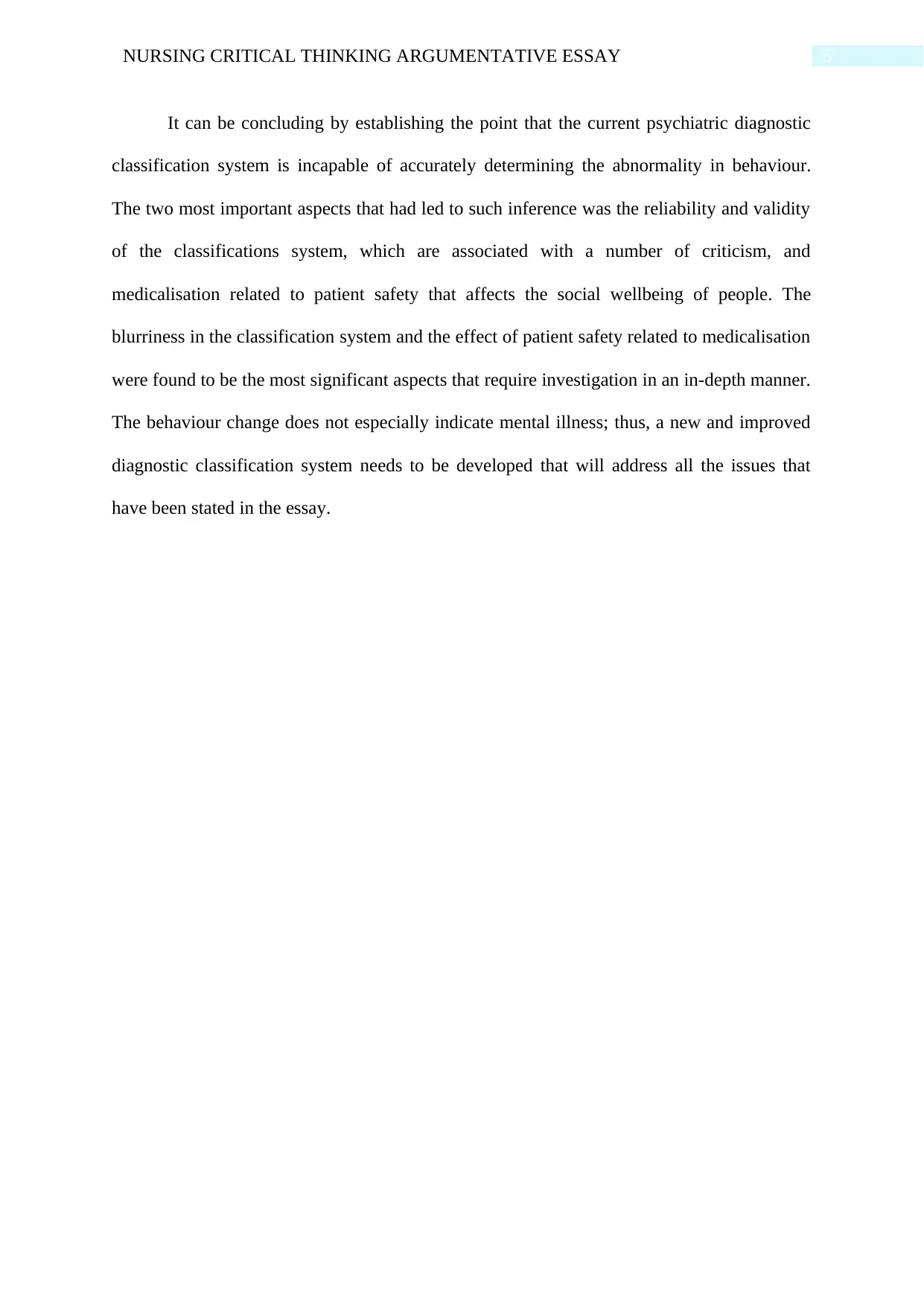
5NURSING CRITICAL THINKING ARGUMENTATIVE ESSAY
It can be concluding by establishing the point that the current psychiatric diagnostic
classification system is incapable of accurately determining the abnormality in behaviour.
The two most important aspects that had led to such inference was the reliability and validity
of the classifications system, which are associated with a number of criticism, and
medicalisation related to patient safety that affects the social wellbeing of people. The
blurriness in the classification system and the effect of patient safety related to medicalisation
were found to be the most significant aspects that require investigation in an in-depth manner.
The behaviour change does not especially indicate mental illness; thus, a new and improved
diagnostic classification system needs to be developed that will address all the issues that
have been stated in the essay.
It can be concluding by establishing the point that the current psychiatric diagnostic
classification system is incapable of accurately determining the abnormality in behaviour.
The two most important aspects that had led to such inference was the reliability and validity
of the classifications system, which are associated with a number of criticism, and
medicalisation related to patient safety that affects the social wellbeing of people. The
blurriness in the classification system and the effect of patient safety related to medicalisation
were found to be the most significant aspects that require investigation in an in-depth manner.
The behaviour change does not especially indicate mental illness; thus, a new and improved
diagnostic classification system needs to be developed that will address all the issues that
have been stated in the essay.
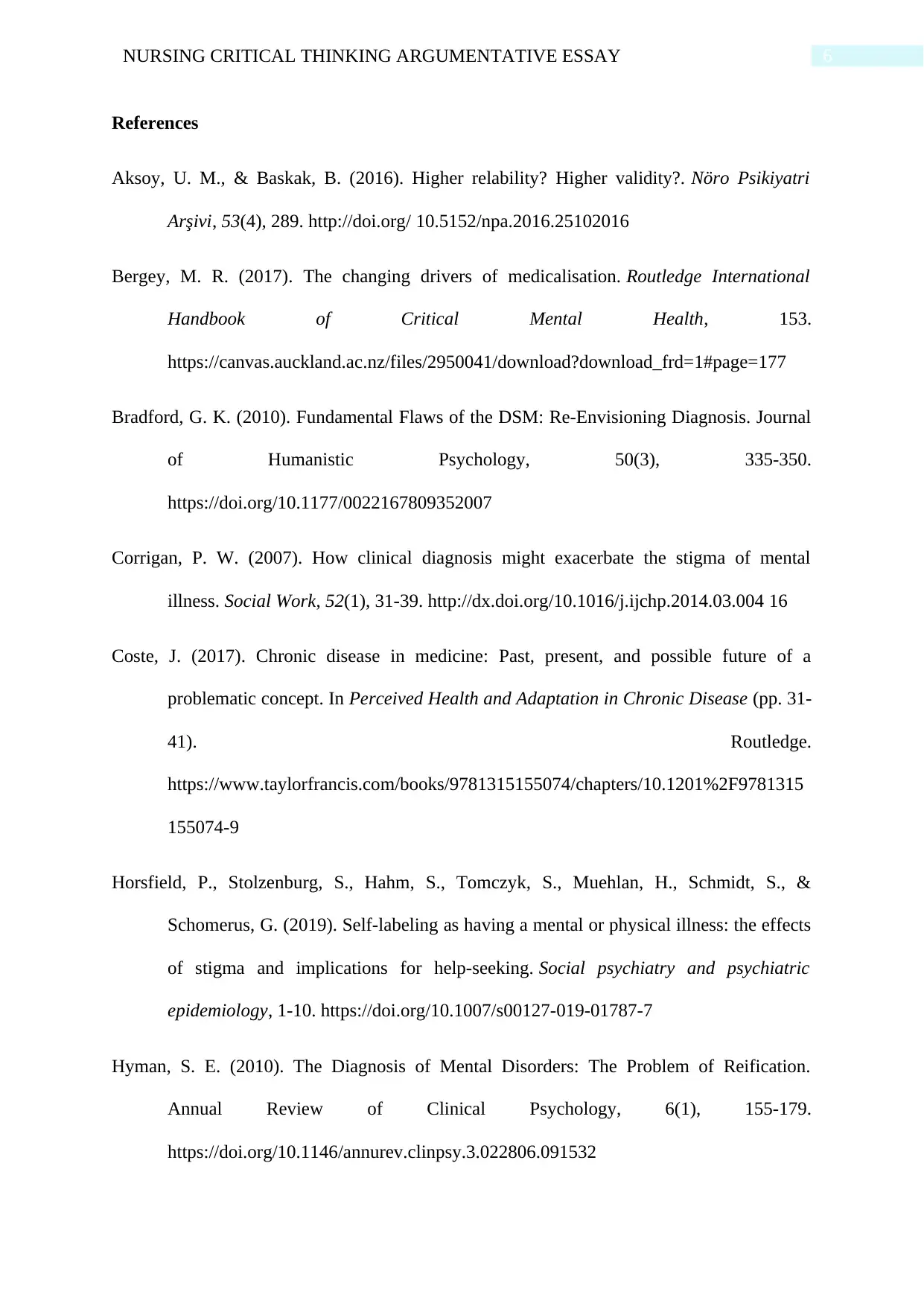
6NURSING CRITICAL THINKING ARGUMENTATIVE ESSAY
References
Aksoy, U. M., & Baskak, B. (2016). Higher relability? Higher validity?. Nöro Psikiyatri
Arşivi, 53(4), 289. http://doi.org/ 10.5152/npa.2016.25102016
Bergey, M. R. (2017). The changing drivers of medicalisation. Routledge International
Handbook of Critical Mental Health, 153.
https://canvas.auckland.ac.nz/files/2950041/download?download_frd=1#page=177
Bradford, G. K. (2010). Fundamental Flaws of the DSM: Re-Envisioning Diagnosis. Journal
of Humanistic Psychology, 50(3), 335-350.
https://doi.org/10.1177/0022167809352007
Corrigan, P. W. (2007). How clinical diagnosis might exacerbate the stigma of mental
illness. Social Work, 52(1), 31-39. http://dx.doi.org/10.1016/j.ijchp.2014.03.004 16
Coste, J. (2017). Chronic disease in medicine: Past, present, and possible future of a
problematic concept. In Perceived Health and Adaptation in Chronic Disease (pp. 31-
41). Routledge.
https://www.taylorfrancis.com/books/9781315155074/chapters/10.1201%2F9781315
155074-9
Horsfield, P., Stolzenburg, S., Hahm, S., Tomczyk, S., Muehlan, H., Schmidt, S., &
Schomerus, G. (2019). Self-labeling as having a mental or physical illness: the effects
of stigma and implications for help-seeking. Social psychiatry and psychiatric
epidemiology, 1-10. https://doi.org/10.1007/s00127-019-01787-7
Hyman, S. E. (2010). The Diagnosis of Mental Disorders: The Problem of Reification.
Annual Review of Clinical Psychology, 6(1), 155-179.
https://doi.org/10.1146/annurev.clinpsy.3.022806.091532
References
Aksoy, U. M., & Baskak, B. (2016). Higher relability? Higher validity?. Nöro Psikiyatri
Arşivi, 53(4), 289. http://doi.org/ 10.5152/npa.2016.25102016
Bergey, M. R. (2017). The changing drivers of medicalisation. Routledge International
Handbook of Critical Mental Health, 153.
https://canvas.auckland.ac.nz/files/2950041/download?download_frd=1#page=177
Bradford, G. K. (2010). Fundamental Flaws of the DSM: Re-Envisioning Diagnosis. Journal
of Humanistic Psychology, 50(3), 335-350.
https://doi.org/10.1177/0022167809352007
Corrigan, P. W. (2007). How clinical diagnosis might exacerbate the stigma of mental
illness. Social Work, 52(1), 31-39. http://dx.doi.org/10.1016/j.ijchp.2014.03.004 16
Coste, J. (2017). Chronic disease in medicine: Past, present, and possible future of a
problematic concept. In Perceived Health and Adaptation in Chronic Disease (pp. 31-
41). Routledge.
https://www.taylorfrancis.com/books/9781315155074/chapters/10.1201%2F9781315
155074-9
Horsfield, P., Stolzenburg, S., Hahm, S., Tomczyk, S., Muehlan, H., Schmidt, S., &
Schomerus, G. (2019). Self-labeling as having a mental or physical illness: the effects
of stigma and implications for help-seeking. Social psychiatry and psychiatric
epidemiology, 1-10. https://doi.org/10.1007/s00127-019-01787-7
Hyman, S. E. (2010). The Diagnosis of Mental Disorders: The Problem of Reification.
Annual Review of Clinical Psychology, 6(1), 155-179.
https://doi.org/10.1146/annurev.clinpsy.3.022806.091532
Paraphrase This Document
Need a fresh take? Get an instant paraphrase of this document with our AI Paraphraser

7NURSING CRITICAL THINKING ARGUMENTATIVE ESSAY
Johnstone, L. (2018). Psychological formulation as an alternative to psychiatric
diagnosis. Journal of Humanistic Psychology, 58(1), 30-46.
https://doi.org/10.1177/0022167817722230
Kapadia, M., Desai, M., & Parikh, R. (2020). Fractures in the framework: limitations of
classification systems in psychiatry. clinical neuroscience, 22(1), 17.
https://www.dialogues-cns.org/wp-content/uploads/2020/03/PARIKH.pdf
Keeley, J. W., Reed, G. M., Roberts, M. C., Evans, S. C., Medina-Mora, M. E., Robles, R., ...
& Andrews, H. F. (2016). Developing a science of clinical utility in diagnostic
classification systems: Field study strategies for ICD-11 mental and behavioral
disorders. American Psychologist, 71(1), 3. http://dx.doi.org/10.1037/a0039972
Landi, A., Berne, R., Speed, W., & Hendler, N. (2018). Comparison of Clinical Diagnoses
versus Computerized Test (Expert System) Diagnoses from the Headache Diagnostic
Paradigm (Expert System). SciFed Journal of Headache and Pain, 1(1).
http://scifedpublishers.com/fulltext/comparison-of-clinical-diagnoses-versus-
computerized-test-expertsystem-diagnoses-from-the-headache-diagnostic-paradigm-
expertsystem/22276#References
Milton, A. C., & Mullan, B. (2017). Views and experience of communication when receiving
a serious mental health diagnosis: satisfaction levels, communication preferences, and
acceptability of the SPIKES protocol. Journal of Mental Health, 26(5), 395-404.
https://doi.org/10.1080/09638237.2016.1207225
Perry, B. L., Frieh, E., & Wright, E. R. (2018). Therapeutic social control of people with
serious mental illness: An empirical verification and extension of theory. Society and
Mental Health, 8(2), 108-122. https://doi.org/10.1177/2156869317725891
Johnstone, L. (2018). Psychological formulation as an alternative to psychiatric
diagnosis. Journal of Humanistic Psychology, 58(1), 30-46.
https://doi.org/10.1177/0022167817722230
Kapadia, M., Desai, M., & Parikh, R. (2020). Fractures in the framework: limitations of
classification systems in psychiatry. clinical neuroscience, 22(1), 17.
https://www.dialogues-cns.org/wp-content/uploads/2020/03/PARIKH.pdf
Keeley, J. W., Reed, G. M., Roberts, M. C., Evans, S. C., Medina-Mora, M. E., Robles, R., ...
& Andrews, H. F. (2016). Developing a science of clinical utility in diagnostic
classification systems: Field study strategies for ICD-11 mental and behavioral
disorders. American Psychologist, 71(1), 3. http://dx.doi.org/10.1037/a0039972
Landi, A., Berne, R., Speed, W., & Hendler, N. (2018). Comparison of Clinical Diagnoses
versus Computerized Test (Expert System) Diagnoses from the Headache Diagnostic
Paradigm (Expert System). SciFed Journal of Headache and Pain, 1(1).
http://scifedpublishers.com/fulltext/comparison-of-clinical-diagnoses-versus-
computerized-test-expertsystem-diagnoses-from-the-headache-diagnostic-paradigm-
expertsystem/22276#References
Milton, A. C., & Mullan, B. (2017). Views and experience of communication when receiving
a serious mental health diagnosis: satisfaction levels, communication preferences, and
acceptability of the SPIKES protocol. Journal of Mental Health, 26(5), 395-404.
https://doi.org/10.1080/09638237.2016.1207225
Perry, B. L., Frieh, E., & Wright, E. R. (2018). Therapeutic social control of people with
serious mental illness: An empirical verification and extension of theory. Society and
Mental Health, 8(2), 108-122. https://doi.org/10.1177/2156869317725891
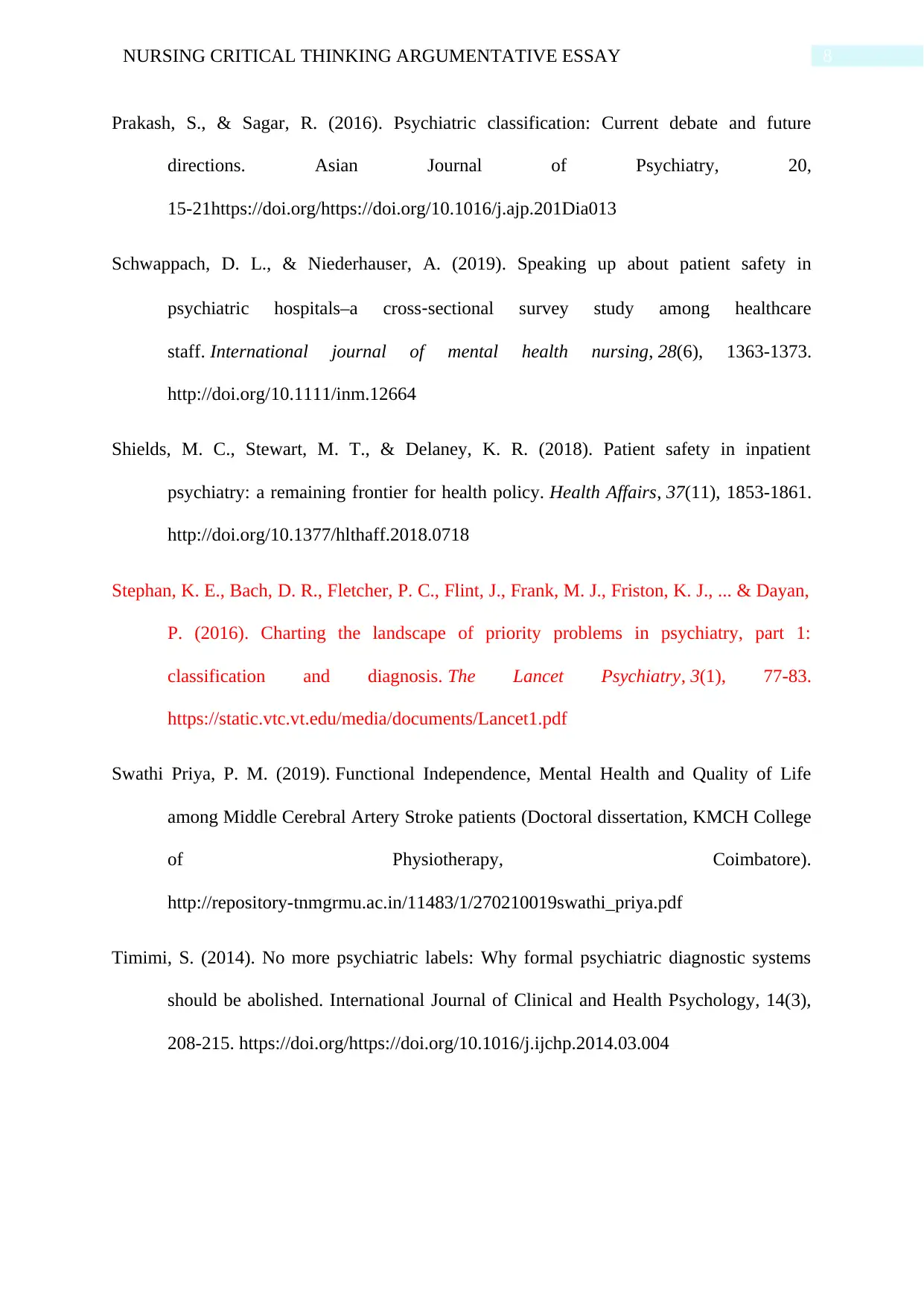
8NURSING CRITICAL THINKING ARGUMENTATIVE ESSAY
Prakash, S., & Sagar, R. (2016). Psychiatric classification: Current debate and future
directions. Asian Journal of Psychiatry, 20,
15-21https://doi.org/https://doi.org/10.1016/j.ajp.201Dia013
Schwappach, D. L., & Niederhauser, A. (2019). Speaking up about patient safety in
psychiatric hospitals–a cross‐sectional survey study among healthcare
staff. International journal of mental health nursing, 28(6), 1363-1373.
http://doi.org/10.1111/inm.12664
Shields, M. C., Stewart, M. T., & Delaney, K. R. (2018). Patient safety in inpatient
psychiatry: a remaining frontier for health policy. Health Affairs, 37(11), 1853-1861.
http://doi.org/10.1377/hlthaff.2018.0718
Stephan, K. E., Bach, D. R., Fletcher, P. C., Flint, J., Frank, M. J., Friston, K. J., ... & Dayan,
P. (2016). Charting the landscape of priority problems in psychiatry, part 1:
classification and diagnosis. The Lancet Psychiatry, 3(1), 77-83.
https://static.vtc.vt.edu/media/documents/Lancet1.pdf
Swathi Priya, P. M. (2019). Functional Independence, Mental Health and Quality of Life
among Middle Cerebral Artery Stroke patients (Doctoral dissertation, KMCH College
of Physiotherapy, Coimbatore).
http://repository-tnmgrmu.ac.in/11483/1/270210019swathi_priya.pdf
Timimi, S. (2014). No more psychiatric labels: Why formal psychiatric diagnostic systems
should be abolished. International Journal of Clinical and Health Psychology, 14(3),
208-215. https://doi.org/https://doi.org/10.1016/j.ijchp.2014.03.004
Prakash, S., & Sagar, R. (2016). Psychiatric classification: Current debate and future
directions. Asian Journal of Psychiatry, 20,
15-21https://doi.org/https://doi.org/10.1016/j.ajp.201Dia013
Schwappach, D. L., & Niederhauser, A. (2019). Speaking up about patient safety in
psychiatric hospitals–a cross‐sectional survey study among healthcare
staff. International journal of mental health nursing, 28(6), 1363-1373.
http://doi.org/10.1111/inm.12664
Shields, M. C., Stewart, M. T., & Delaney, K. R. (2018). Patient safety in inpatient
psychiatry: a remaining frontier for health policy. Health Affairs, 37(11), 1853-1861.
http://doi.org/10.1377/hlthaff.2018.0718
Stephan, K. E., Bach, D. R., Fletcher, P. C., Flint, J., Frank, M. J., Friston, K. J., ... & Dayan,
P. (2016). Charting the landscape of priority problems in psychiatry, part 1:
classification and diagnosis. The Lancet Psychiatry, 3(1), 77-83.
https://static.vtc.vt.edu/media/documents/Lancet1.pdf
Swathi Priya, P. M. (2019). Functional Independence, Mental Health and Quality of Life
among Middle Cerebral Artery Stroke patients (Doctoral dissertation, KMCH College
of Physiotherapy, Coimbatore).
http://repository-tnmgrmu.ac.in/11483/1/270210019swathi_priya.pdf
Timimi, S. (2014). No more psychiatric labels: Why formal psychiatric diagnostic systems
should be abolished. International Journal of Clinical and Health Psychology, 14(3),
208-215. https://doi.org/https://doi.org/10.1016/j.ijchp.2014.03.004
1 out of 9
Related Documents
Your All-in-One AI-Powered Toolkit for Academic Success.
+13062052269
info@desklib.com
Available 24*7 on WhatsApp / Email
![[object Object]](/_next/static/media/star-bottom.7253800d.svg)
Unlock your academic potential
© 2024 | Zucol Services PVT LTD | All rights reserved.





